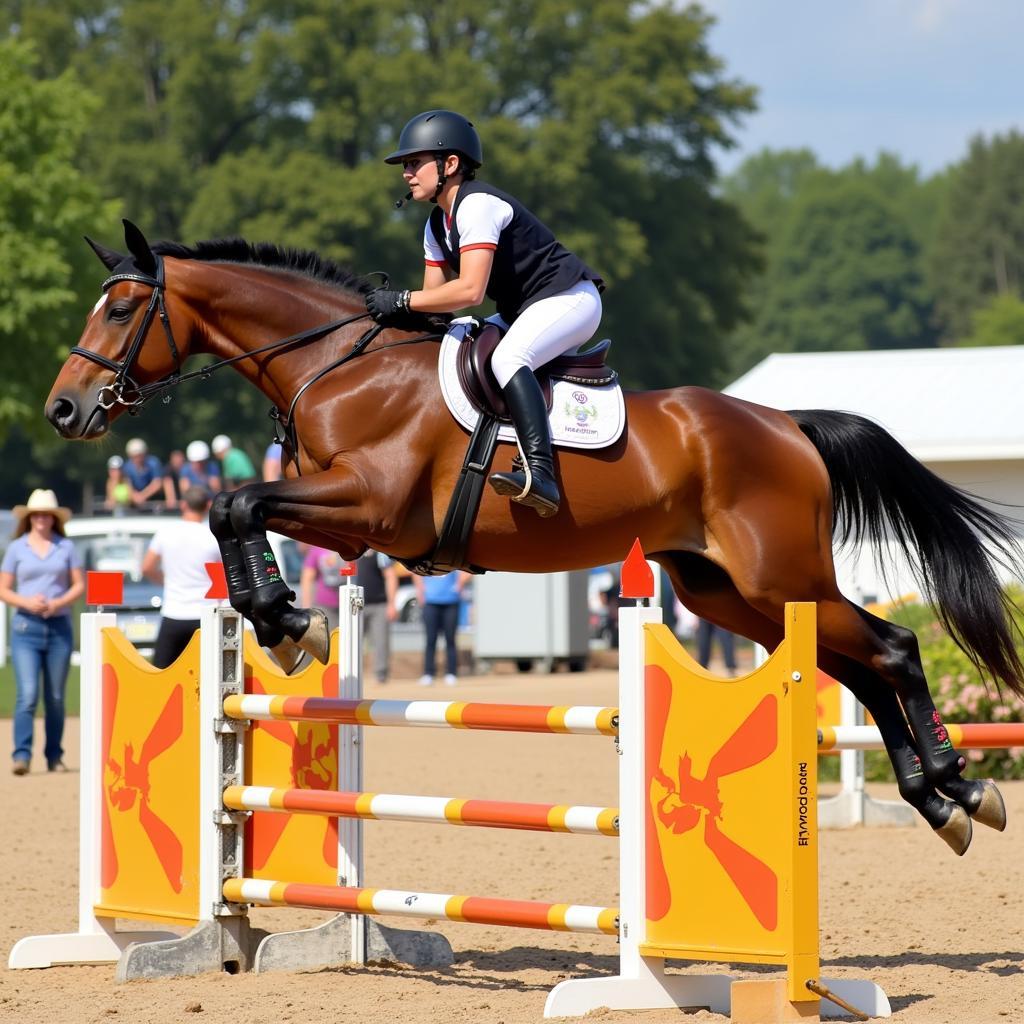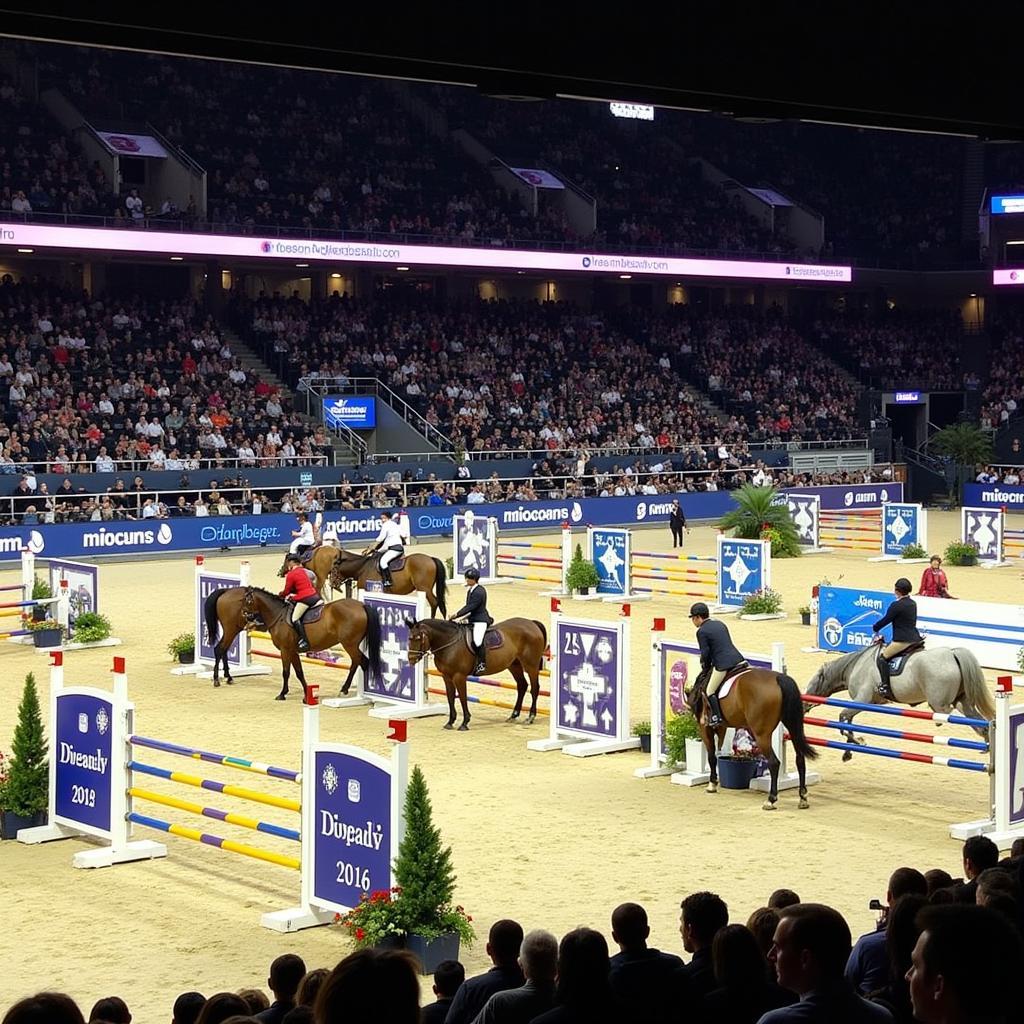Leaping Horses, a sight of breathtaking power and grace, have captivated humans for centuries. From the thrill of equestrian competitions to the timeless beauty captured in art, the image of a horse in mid-air embodies freedom and athleticism. This article delves into the mechanics of equine leaping, exploring the physical attributes and training techniques that enable these magnificent animals to achieve such impressive feats.  A horse leaping over a high jump in a show jumping competition
A horse leaping over a high jump in a show jumping competition
The Biomechanics of a Leaping Horse
The ability of a horse to leap is rooted in its unique anatomy and physiology. Strong leg muscles, a flexible spine, and powerful hindquarters provide the necessary propulsion for a horse to launch itself off the ground. When a horse prepares to jump, it gathers its body, lowers its hindquarters, and then explosively extends its hind legs, propelling itself upwards and forwards. The forelegs extend to clear the obstacle, and the horse lands gracefully, absorbing the impact with its strong legs and flexible joints. Understanding these biomechanics is crucial for both riders and trainers.
What makes a horse a good jumper? While training plays a vital role, inherent physical characteristics also contribute significantly. A horse with a longer stride and a naturally powerful build will have a distinct advantage. Furthermore, a horse’s temperament and willingness to cooperate with its rider are equally important.
Training Techniques for Leaping Horses
Training a horse to leap safely and effectively requires patience, expertise, and a deep understanding of the animal’s physical and mental capabilities. Starting with low obstacles, trainers gradually increase the height and complexity of the jumps, allowing the horse to develop strength, confidence, and coordination. Positive reinforcement techniques are essential to build a positive association with jumping and encourage the horse to perform at its best.
Proper conditioning is also crucial for preparing a horse for jumping. Regular exercise, a balanced diet, and appropriate rest periods help maintain the horse’s physical fitness and prevent injuries.
Building Confidence and Trust
Beyond the physical training, building a strong bond of trust and understanding between horse and rider is paramount. Clear communication through subtle cues and aids helps the horse understand what is expected of it and builds its confidence to tackle challenging jumps. A trusting relationship between horse and rider fosters a sense of partnership and encourages the horse to perform to its full potential.
How do you teach a horse to leap higher? It’s a gradual process that involves incrementally raising the height of the obstacles while ensuring the horse maintains proper form and confidence. Rushing the process can lead to fear and hesitation, hindering the horse’s progress and potentially causing injury. Leaping horse cabernet sauvignon
Common Leaping Horse Disciplines
Several equestrian disciplines showcase the spectacular leaping abilities of horses. Show jumping, eventing, and hunter competitions each have unique requirements and judging criteria, but all involve the horse clearing a series of obstacles with precision and athleticism. Understanding the nuances of each discipline can deepen your appreciation for the skill and training involved in leaping horses.
Show Jumping: A Test of Precision
Show jumping focuses on the horse’s ability to clear a course of obstacles cleanly and within a specific time limit. Penalties are incurred for knocking down rails or exceeding the allotted time. The race horse decor can reflect this elegance.  Horses and riders competing in a show jumping competition
Horses and riders competing in a show jumping competition
Dr. Emily Carter, a renowned equine veterinarian, emphasizes the importance of proper warm-up and cool-down routines for jumping horses: “Adequate preparation and recovery are vital for preventing injuries and ensuring the horse’s long-term well-being.” Remember the stunning salvador dali paintings horse capturing this energy.
The Beauty and Athleticism of Leaping Horses
Leaping horses embody a unique combination of power, grace, and athleticism. Understanding the biomechanics, training techniques, and various disciplines involved in equine jumping deepens our appreciation for these magnificent animals. From the thrill of competition to the artistry of equestrian photography, leaping horses continue to inspire and captivate. horse rao offers some insight.
Have you ever wondered what the ideal conformation is for a jumping horse? A well-balanced physique with strong hindquarters, a flexible back, and long, sloping shoulders contributes to a horse’s jumping ability. This allows for powerful propulsion and efficient clearance over obstacles.
In conclusion, leaping horses represent the pinnacle of equine athleticism. Their ability to soar through the air is a testament to their physical prowess and the dedicated training they receive. diving horse restaurant avalon nj celebrates this iconic imagery.
When you need assistance, please contact us at Phone Number: 0772127271, Email: [email protected] or visit us at QGM2+WX2, Vị Trung, Vị Thuỷ, Hậu Giang, Việt Nam. We have a 24/7 customer service team.